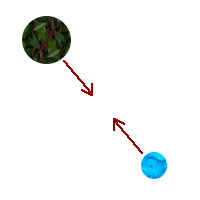Gravitational ForcePopular (but most likely incorrect) myth has it that Isaac Newton made the link between the force that keep the planets in motion and the force that keeps objects on the Earth while observing an apple falling from a tree. While the story may not be true, the observation is. All objects in the universe feel an attractive force towards each other which increases with the mass of the objects and decreases with the distance. This is why more massive objects are harder to lift on the Earth. The Earth's gravitational pull is harder on heavier object because of their greater mass. Newton's theory was that all objects have an attractive force between them which is proportional to the product of their masses, and inversely proportional to the square of the distance between them.
Fg=G M1 M2 / r2 Where: Fg = Gravitational Force G = the constant of proportionality, referred to as the Graviational constant. In SI units, G=6.67 x 10-11 Nm2/kg2. M1 = Mass of 1st object M2 = Mass of 2nd object  Report technical/content problems here |